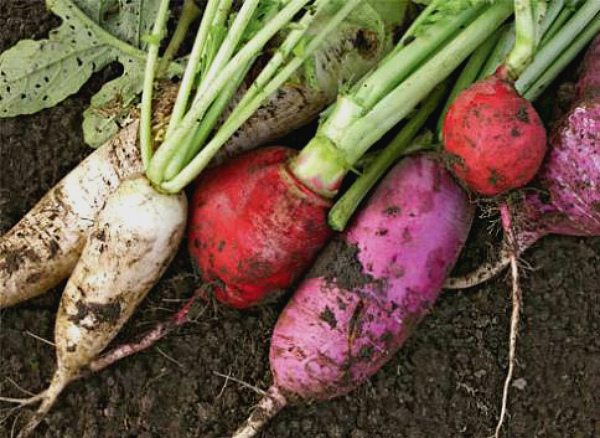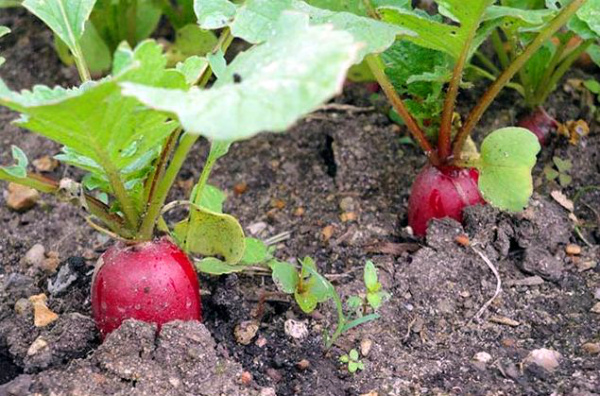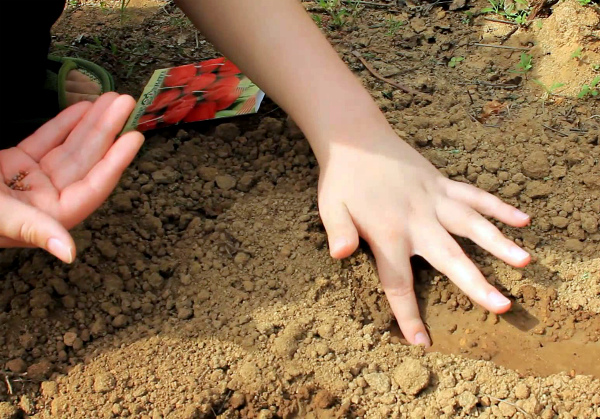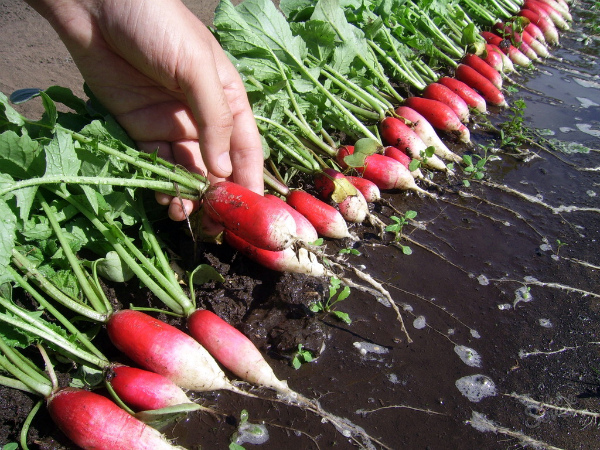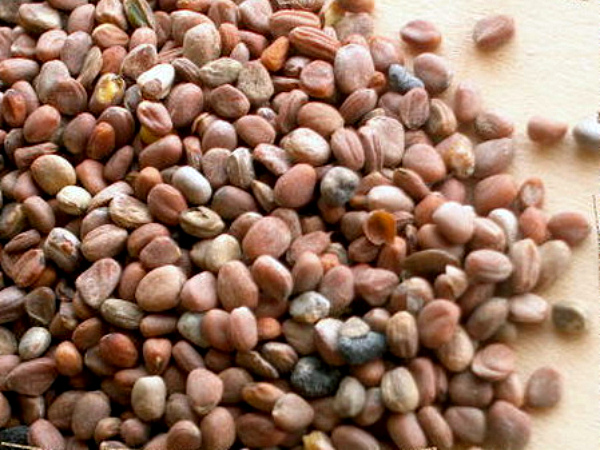How to plant radishes and when
Content
Biological features
Radish is an annual crop belonging to the Cabbage family. The plant consists of a leaf rosette and a root vegetable, which is eaten. Depending on the variety, the root crop can have a very different shape, size and color. Most often, radish has a round or oval shape, but there are specimens of conical, fusiform and elliptical shapes. The standard size of root crops is 2–5 cm in diameter and 15–25 g in weight, but there are varieties with larger roots. The most common for radishes is considered a red-pink or variegated red-white color, but not so long ago, new varieties have appeared that have a yellow, white, gray and even purple color.
Radish is characterized by a pungent taste, which is due to the presence of mustard oil glycosides. As a vegetable crop, it is grown and used in cooking everywhere, since it has a considerable set of vitamins and the ability to strengthen the immune system. In addition, the plant easily tolerates transplanting and temperature changes (it is not damaged by light frosts), so you can plant radishes in early spring, at the end of March or in April, as soon as the ground thaws 3-5 cm.
The culture propagates by seeds that have the ability to germinate quickly. If they are soaked before sowing, the first shoots will appear literally in 2-3 days. Therefore, radishes are often sown in rows to mark the lines of beds with other crops. The radish root crop also grows very quickly. Early varieties are ready for use 3-4 weeks after the seeds have been sown in the ground.
According to the ripening period, radish varieties are divided into the following types:
- early ripening - root crops are ready for digging out 20-30 days after sowing;
- mid-ripening - the ripening period is 30-40 days;
- late ripening (45-60 days) - you can dig out the crop only in June, or even in July, provided that the seeds were planted in April or May.
When sown with seeds, radish grows well in greenhouses and greenhouses. In favorable conditions (good humidity and air temperature + 18 ... + 20 ° C) sprouts appear in 2-4 days, but then the temperature must be lowered to + 15 ... + 18 ° C - this degree contributes to the early formation of root crops. Plants do not need a long day of light - with natural light for more than 12 hours a day, they turn to flowering. It is also important to dig up the radish on time, since 10-14 days after the root crop has grown, a peduncle appears on the plant, and the radish itself loses its taste.
Landing dates
The question of when it is possible to sow radishes in order to get an early harvest and at the same time the crops are not frozen is of concern to any gardener. As already mentioned, radish is a frost-resistant crop and tolerates wave-like spring frosts well. In early spring, it can be sown immediately with seeds in the ground, without fear that they will freeze.However, when planting radishes in March, it is better to place the garden bed under a film so that the seeds germinate sooner. Alternatively, you can build a film greenhouse, and remove the film with the arrival of warm days.
The most favorable soil temperature for sowing radish with seeds is + 12 ... + 15 ° C. The earth reaches this degree somewhere in the middle or at the end of April. In the northern regions, radish seeds are usually sown in the ground in May and, accordingly, the harvest is harvested a little later - in June or July. You can also sow the crop at the end of August, when the summer heat is gone and the daylight hours get shorter. Many gardeners prefer to sow seeds at the end of summer, since the soil has cooled down a little, and there is still enough time for the formation of tubers. Judging by the reviews, autumn radish is sweeter and almost never empty inside.
In principle, you can sow a vegetable with seeds all year round, with the exception of June and July.
This is due to the fact that in June and July the temperature of the air and soil is too high, and in such conditions, the roots will become bitter or not form at all, in addition, the plants can release flower stalks. During the winter months, radishes are sown as seeds only in greenhouses.
Also, some gardeners practice planting radishes before winter, that is, the seeds are sown in the ground in late autumn, just before the frosts, and they germinate next spring. This practice allows you to grow a very early and high-quality radish, since during the winter the seeds are hardened, and then good root crops grow from them. Another plus of winter sowing is that the ground is constantly wet under the snow, which contributes to the swelling and rapid germination of seeds.
Landing technology
Radish is sown as seeds directly into the ground. The soil for growing crops is prepared in advance: for spring sowing - in the fall, for sowing during the season - in a couple of weeks. Radishes grow best in loose and fertile soil enriched with humus. If the soil is acidic, it must be limed to equalize the acidity. Before digging, humus and compost are introduced into the soil, after which the bed is dug up with a pitchfork. If the soil is not very fertile, you can add mineral fertilizers: potassium chloride, superphosphate, ash.
A well-lit area should be allocated for the garden. Radishes can grow in partial shade, but in this case the roots will be small. Pay attention to the predecessors of radish - the culture does not grow well after cabbage vegetables, salad. You can sow seeds in the place where you later plan to plant tomatoes, peppers - this technique will save the area of the garden. The bed should be high, at least 15–20 cm.
Before planting radish seeds, it is recommended to soak and calibrate (select the largest ones) - this is the only way you can accelerate germination and ensure you get high-quality root crops.
To check the quality of the seeds, you need to fill them with water. Those that sink to the bottom can be used for seeding.
You can soak the seeds in plain warm water or in a growth-stimulating solution. Alternatively, the planting material can be placed in a damp cloth (gauze) and put in a warm place for a couple of days.
If everything is in order with the seeds, they are calibrated and germinated, you can start planting. Along the length of the entire bed we make shallow (5 cm) furrows at a distance of 10-15 cm. We water the well well and place the seed. Sowing radish with seeds assumes their placement in the hole in a checkerboard pattern at a distance of 3-4 cm. Of course, the process is very troublesome, and if you cannot do it, then you can sow more densely and then thin out the rows. Further, the holes are covered with a layer of earth, and if the weather is cold, then the bed is covered with a film.
Video "One of the ways to plant radishes"
This video will walk you through one way of planting radish seeds outdoors.
Care
Caring for the garden bed consists of timely watering, cleaning weeds and loosening the soil.For the intensive growth of root crops, it is necessary to maintain normal humidity - make sure that the soil does not dry out, but also is not overly moist. If the summer is hot, it should be watered daily, the rest of the time - once every 2-3 days. Sprinkling can be done in the evening. After each watering, it is necessary to slightly loosen the soil in the aisles, and also remove weeds. In the spring, as soon as 1-2 leaves appear on the sprouts, the garden must be thinned out - only the strongest plants should be left at a distance of 4-5 cm from each other.
The main pests of radish are cabbage flies and cruciferous fleas. To protect against these insects, it is recommended to spray the beds with an ash solution or tobacco infusion. If the bed was prepared correctly, then the radish sown with seeds in the spring does not need feeding. When sowing in autumn, potash fertilizers or compost must be added, since the soil has become a little depleted over the summer.
Radish is used fresh. Root crops from spring sowing should be dug out in time, since they quickly overripe in warm ground. If the harvest is ripe in the fall, then you can take your time with harvesting - in the cold ground, the roots will stay fresh longer. In a cool place (-2 ... 0 ˚С), radishes are stored for quite a long time. Late varieties, ripening in July, can be refrigerated for most of the summer. It is better to store the autumn harvest in a cellar or basement, while the tops must be removed, and the root crops must be sprinkled with sand.
Video "How to get a good harvest of radish"
With proper agricultural technology, several crops of radish are obtained from one garden bed per season. What you need to do to grow a good harvest, you will learn from this video.

